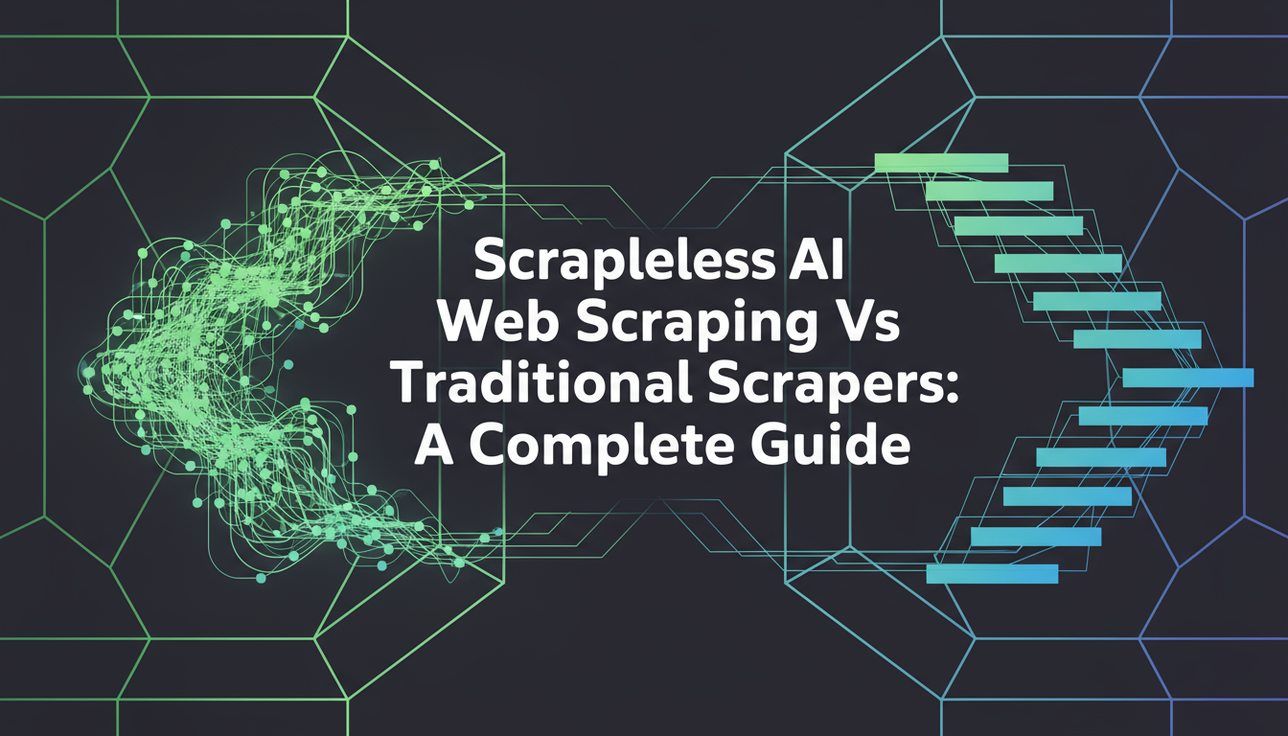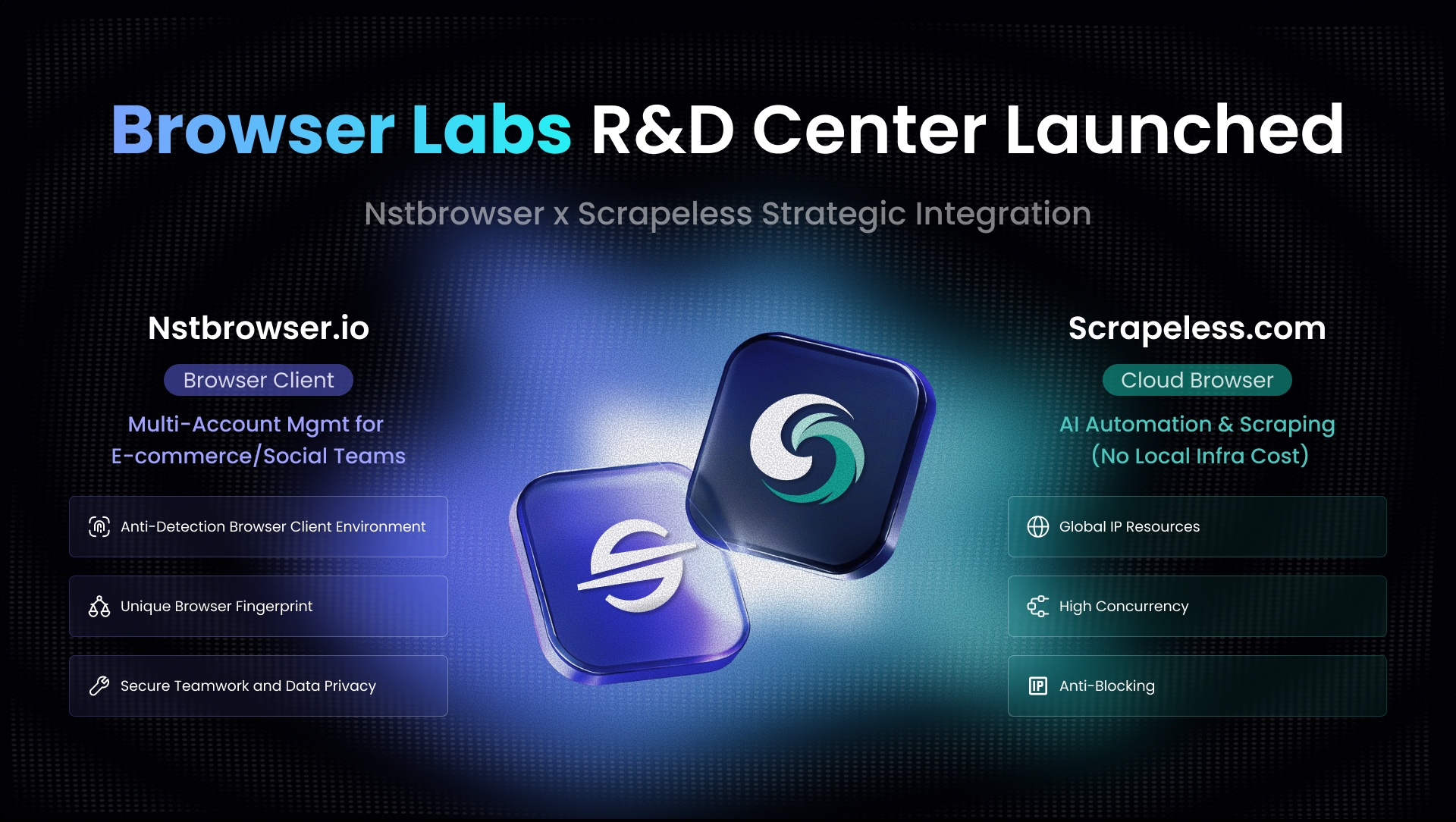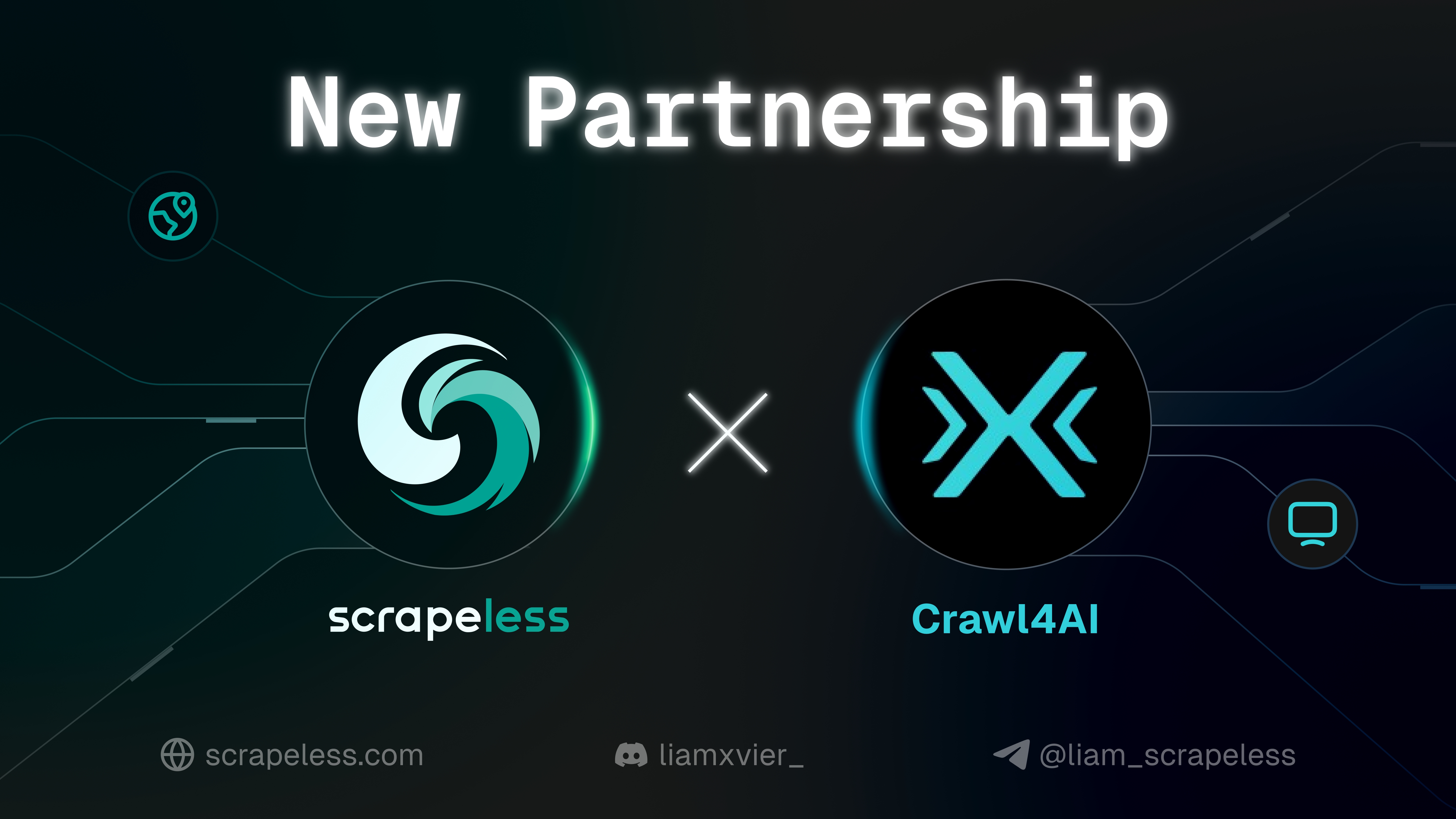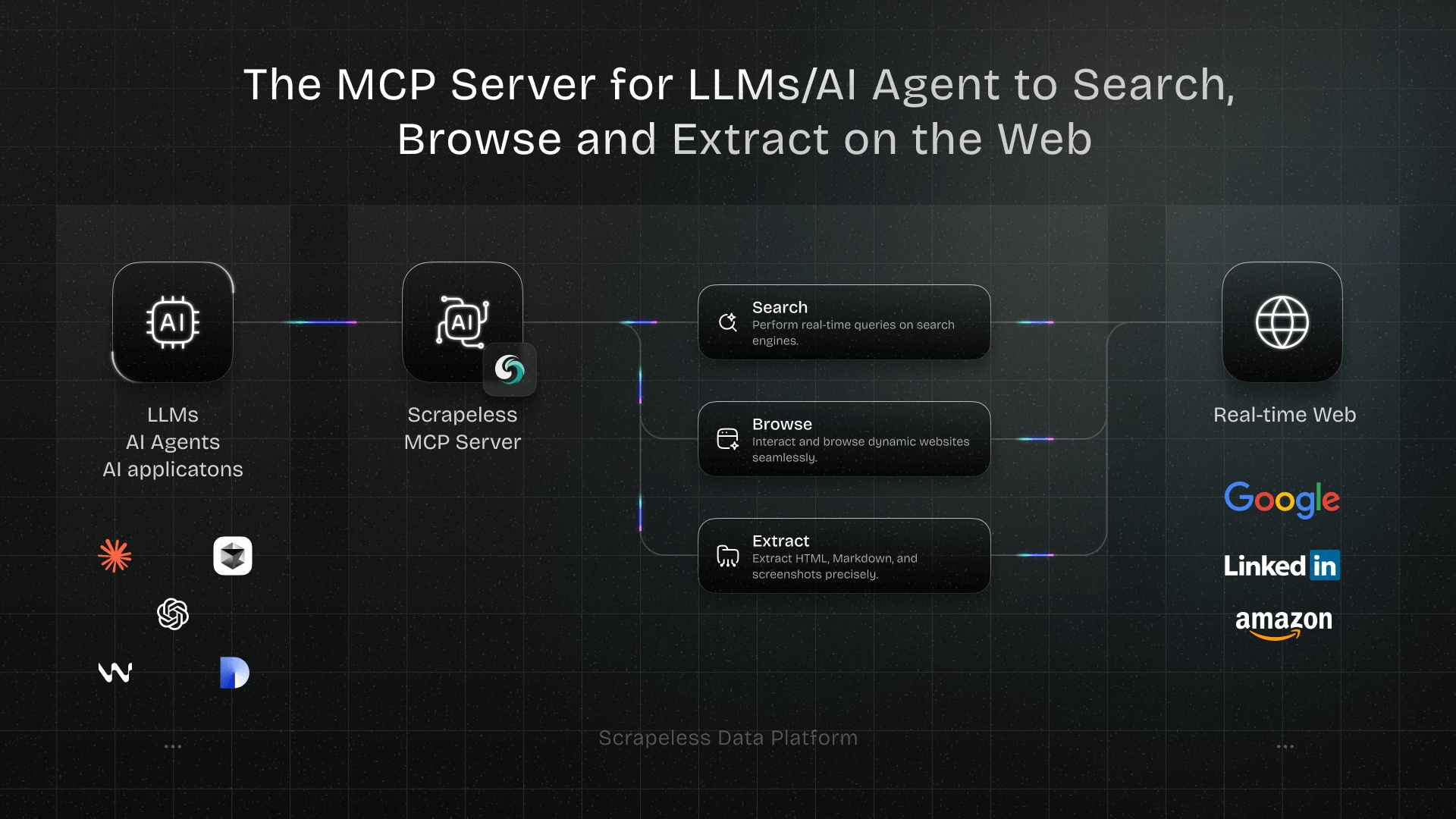Scrapeless AI Web Scraping Vs Traditional Scrapers: A Complete Guide
Advanced Bot Mitigation Engineer
The landscape of web data extraction is undergoing a profound transformation, driven by the rapid advancements in Artificial Intelligence. For years, traditional web scrapers have been the workhorses of data collection, relying on meticulously crafted rules and selectors. However, as websites become increasingly dynamic and fortified with sophisticated anti-bot measures, these conventional methods are facing unprecedented challenges. Enter Scrapeless AI Web Scraping, a revolutionary approach that leverages AI to overcome these hurdles, offering unparalleled efficiency, adaptability, and reliability. This comprehensive guide will delve into a detailed comparison of these two paradigms, highlighting the limitations of traditional scrapers and showcasing how Scrapeless AI provides a superior, future-proof solution for all your data extraction needs.
Key Takeaways
- Traditional web scrapers rely on fixed rules (CSS selectors, XPath) and struggle with dynamic content, anti-bot measures, and website changes.
- Scrapeless AI Web Scraping uses AI and machine learning to intelligently identify and extract data, adapting to website changes and bypassing complex anti-bot systems.
- AI-powered scrapers offer superior adaptability, higher success rates, reduced maintenance, and better scalability compared to traditional methods.
- Scrapeless AI provides an integrated, cloud-based solution that automates proxy management, browser fingerprinting, and CAPTCHA solving, simplifying the entire scraping process.
- While traditional scrapers might be quicker for simple, static sites, Scrapeless AI is more cost-effective and reliable for complex, large-scale, and dynamic web scraping projects.
- The future of web scraping lies in AI-driven solutions that can intelligently navigate the complexities of the modern web, making Scrapeless AI a leading choice.
The Limitations of Traditional Web Scrapers in 2025
Traditional web scrapers typically operate by sending HTTP requests to a website and then parsing the HTML response to extract data. This approach relies heavily on predefined rules, such as CSS selectors or XPath expressions, to locate specific elements on a page. While effective for static websites with consistent structures, this method faces numerous challenges in the modern web environment:
- Dynamic Content (JavaScript-rendered): Most contemporary websites heavily rely on JavaScript to load content dynamically. Traditional scrapers that only fetch raw HTML often fail to retrieve data that is rendered client-side, leading to incomplete or empty results. This is a significant hurdle for sites built with frameworks like React, Angular, or Vue.js [1].
- Anti-Bot Measures: Websites employ increasingly sophisticated anti-bot technologies (e.g., Cloudflare, reCAPTCHA, Akamai Bot Manager) to prevent automated access. These systems detect and block scrapers based on IP addresses, user-agent strings, browser fingerprints, and behavioral patterns. Traditional scrapers often lack the intelligence to bypass these measures, resulting in frequent blocks and CAPTCHAs [2].
- Website Structure Changes: Websites are constantly updated, and even minor changes to their HTML structure (e.g., a class name change, a new div wrapper) can break traditional scrapers. This necessitates constant monitoring and maintenance, which can be time-consuming and costly.
- Session Management and Authentication: Scraping websites that require login or maintain sessions (e.g., e-commerce sites, social media platforms) is complex with traditional scrapers. Managing cookies, handling redirects, and maintaining session state adds significant overhead.
- Rate Limiting and IP Bans: Websites often implement rate limits to prevent abuse. Sending too many requests from a single IP address can lead to temporary or permanent IP bans, rendering the scraper ineffective. Traditional scrapers require external proxy management to mitigate this.
- Data Quality and Consistency: Without intelligent parsing, traditional scrapers can sometimes extract inconsistent or malformed data, especially when dealing with variations in website layouts or missing elements. Cleaning and validating this data often requires additional post-processing.
- Scalability Issues: Scaling traditional scrapers to handle large volumes of data or high concurrency can be challenging. It requires managing a fleet of machines, proxy infrastructure, and error handling, which can be resource-intensive and complex to orchestrate.
- Lack of Adaptability: Traditional scrapers are rigid; they follow predefined rules. They cannot adapt to unexpected changes, new website layouts, or novel anti-bot challenges without manual intervention and code modifications.
- Resource Intensive (for complex setups): While simple traditional scrapers are lightweight, building a robust traditional scraper that can handle dynamic content, proxies, and basic anti-detection can become quite resource-intensive in terms of development time and infrastructure.
- Limited Data Extraction Capabilities: Traditional scrapers are typically limited to extracting visible text and attributes. They struggle with more complex data extraction tasks, such as understanding the sentiment of text, categorizing unstructured data, or identifying relationships between disparate pieces of information without extensive custom logic.
These limitations highlight the growing need for more intelligent and adaptive solutions, paving the way for Scrapeless AI Web Scraping to redefine data extraction.
Scrapeless AI Web Scraping: The Intelligent Approach
Scrapeless AI Web Scraping represents the next generation of data extraction technology. By integrating Artificial Intelligence and Machine Learning, it moves beyond rigid rules to offer a dynamic, adaptive, and highly effective solution for navigating the complexities of the modern web. Scrapeless AI is not just a tool; it's a comprehensive platform designed to overcome the inherent weaknesses of traditional scrapers.
Key Advantages and How Scrapeless AI Works
- Intelligent Dynamic Content Handling: Unlike traditional scrapers, Scrapeless AI utilizes a headless cloud browser that fully renders JavaScript, just like a human user's browser. Its AI algorithms can then intelligently identify and extract data from dynamically loaded content, ensuring complete data capture from even the most complex single-page applications (SPAs) [3].
- Advanced Anti-Detection and Bypass: Scrapeless AI employs state-of-the-art AI models to analyze and adapt to anti-bot measures in real-time. It dynamically adjusts browser fingerprints, manages a globally distributed proxy network, and simulates human-like browsing behavior (clicks, scrolls, typing) to bypass CAPTCHAs, Cloudflare, and other sophisticated bot detection systems automatically. This significantly increases success rates and reduces blocking [4].
- Resilience to Website Changes: AI-powered scrapers can learn from website structures and adapt to minor changes without requiring code modifications. Scrapeless AI uses visual recognition and semantic understanding to locate data elements, making it less susceptible to breakage from CSS selector or XPath changes. If a button moves, the AI can still find it.
- Seamless Session and Authentication Management: Scrapeless AI handles complex session management, cookie handling, and authentication flows automatically. Users can configure login credentials, and the AI will manage the entire authentication process, allowing for seamless scraping of protected content.
- Automated Proxy Management and Rotation: Scrapeless AI integrates a managed, high-quality proxy network. It automatically rotates IP addresses, selects optimal proxy types (residential, datacenter), and handles retries, eliminating the need for users to manage their own proxy infrastructure and preventing IP bans.
- Enhanced Data Quality and Structure: AI models can understand the context of data, leading to more accurate and consistent extraction. Scrapeless AI can identify and structure data even from semi-structured or unstructured sources, reducing the need for extensive post-processing and improving overall data quality.
- Effortless Scalability: Built as a cloud-native platform, Scrapeless AI offers inherent scalability. It can handle millions of requests concurrently and process vast amounts of data without users needing to worry about server infrastructure, load balancing, or resource allocation. This makes it ideal for large-scale projects.
- Adaptability and Learning: The core strength of Scrapeless AI is its ability to learn and adapt. It continuously improves its scraping strategies based on new encounters with anti-bot systems and website structures, making it a future-proof solution against evolving web complexities.
- Reduced Maintenance and Cost-Effectiveness: By automating many of the challenges associated with traditional scraping (anti-detection, proxy management, structure changes), Scrapeless AI significantly reduces maintenance overhead. While there's a subscription cost, the savings in development time, infrastructure, and successful data acquisition often make it more cost-effective in the long run.
- Advanced Data Extraction Capabilities: Beyond simple text extraction, Scrapeless AI can perform more sophisticated tasks like sentiment analysis, entity recognition, and even generate summaries from extracted content, providing deeper insights directly from the raw web data. This is particularly useful for LLM-ready data preparation.
Code Operation Steps for Scrapeless AI Web Scraping (API-driven)
One of the most compelling aspects of Scrapeless AI is its simplified API, which abstracts away the complexities of web scraping. Here’s a basic example demonstrating how to use the Scrapeless API to perform AI-powered web scraping:
python
import requests
url = "https://api.scrapeless.com/v1/scrape"
headers = {
"Authorization": "Bearer YOUR_API_KEY", # Replace with your actual API key
"Content-Type": "application/json"
}
payload = {
"target_url": "https://www.example.com/product-page",
"render_js": True, # Essential for dynamic content
"wait_for_selector": ".product-description", # Wait for a specific element to ensure content is loaded
"extract_rules": {
"product_name": "h1.product-title",
"price": ".price-value",
"description": ".product-description",
"reviews_count": ".reviews-count"
},
"ai_extract": True, # Enable AI-powered extraction for better adaptability
"proxy_type": "residential" # Specify proxy type if needed, managed automatically by Scrapeless
}
response = requests.post(url, headers=headers, json=payload)
if response.status_code == 200:
data = response.json()
print("Successfully scraped data:", data)
else:
print("Error during scraping:", response.status_code, response.text)In this example, you provide the target URL and define simple extraction rules. By setting render_js: True and ai_extract: True, you instruct Scrapeless to use its headless browser to render JavaScript and its AI capabilities to intelligently extract the data. Scrapeless automatically handles proxy rotation, anti-bot bypass, and browser fingerprinting in the background. This allows you to focus on the data you need, rather than the technical intricacies of acquiring it.
Direct Comparison: Scrapeless AI Web Scraping vs. Traditional Scrapers
To illustrate the fundamental differences and advantages, let's compare Scrapeless AI Web Scraping with Traditional Scrapers across key operational and performance metrics:
| Feature / Aspect | Traditional Scrapers | Scrapeless AI Web Scraping |
|---|---|---|
| Content Handling | Struggles with dynamic (JavaScript-rendered) content | Intelligently handles dynamic content via headless cloud browser |
| Anti-Bot Bypass | Limited, prone to blocks, requires manual anti-detection logic | AI-driven, dynamic anti-detection, automated CAPTCHA/Cloudflare bypass |
| Website Changes | Highly fragile, breaks with minor structural changes, high maintenance | Resilient, adapts to structural changes using visual/semantic understanding |
| Proxy Management | Requires external proxy integration and manual management | Automated, integrated, globally distributed proxy network |
| Scalability | Complex to scale, resource-intensive infrastructure management | Cloud-native, effortless scalability, high concurrency |
| Development Effort | High (coding, debugging, anti-detection logic) | Low (simple API, visual interface, AI handles complexity) |
| Maintenance Effort | High (constant monitoring, rule updates, anti-bot adjustments) | Low (managed service, AI adapts automatically) |
| Data Quality | Can be inconsistent, requires post-processing | High, AI ensures accurate and structured data extraction |
| Cost-Effectiveness | Low initial cost, high hidden costs (dev time, maintenance, failed scrapes) | Subscription-based, high ROI due to efficiency and reliability |
| Ideal Use Case | Simple, static websites with stable structures | Complex, dynamic, anti-bot protected websites, large-scale projects |
External Authoritative Data and Sources
- A report by Grand View Research indicates that the global web scraping market size was valued at USD 1.3 billion in 2022 and is expected to grow at a compound annual growth rate (CAGR) of 14.3% from 2023 to 2030, driven by the increasing demand for data-driven decision-making. The report also highlights the challenges posed by dynamic content and anti-bot measures. Grand View Research
- According to a study by Statista, over 50% of all internet traffic is now automated, with a significant portion being malicious bots. This necessitates advanced anti-bot measures by websites, making traditional scraping increasingly difficult. Statista
- A blog post by Scrapeless details how its AI-powered scraping browser handles dynamic content and mimics human behavior for high performance. Scrapeless Scraping Browser
- Forbes Technology Council discusses how AI web scrapers can revolutionize data extraction by effectively handling dynamic websites with improved accuracy, speed, and coverage. Forbes Technology Council
Internal Links to Scrapeless Blog
- Discover how Scrapeless handles complex websites in Scrapeless Browser Vs Puppeteer Stealth: Which Is Better For Scraping?.
- Learn about the future of automation with our Headless Cloud Browser For AI And Automation (Ultimate 2025 Guide).
- Explore how no-code solutions are democratizing data extraction in No-Code Web Scraping Services For Beginners (Easy & Fast Setup).
Conclusion: Embracing the Future with Scrapeless AI Web Scraping
The shift from traditional web scrapers to Scrapeless AI Web Scraping is not merely an upgrade; it's a fundamental change in how we approach data extraction. While traditional methods served their purpose for simpler web environments, they are increasingly inadequate for the dynamic, anti-bot protected web of 2025. The constant battle against website changes, anti-bot measures, and the complexities of dynamic content makes traditional scraping a high-maintenance, often unreliable endeavor.
Scrapeless AI Web Scraping offers a powerful, intelligent, and integrated solution that addresses these challenges head-on. By leveraging AI, headless cloud browsers, and automated infrastructure management, it provides unparalleled adaptability, reliability, and scalability. It empowers users to focus on the insights derived from data rather than the arduous process of acquiring it. For any serious data extraction project in today's web landscape, embracing an AI-driven solution like Scrapeless is not just an option—it's a necessity for success.
Ready to revolutionize your data extraction with AI?
Try Scrapeless for Free Today!
Frequently Asked Questions (FAQ)
Q1: What makes Scrapeless AI Web Scraping different from traditional methods?
Scrapeless AI Web Scraping differs by using Artificial Intelligence and a headless cloud browser to intelligently adapt to website changes, bypass anti-bot measures, and extract data from dynamic content automatically. Traditional methods rely on fixed rules and often break when websites change or encounter advanced protections.
Q2: Can traditional scrapers still be used effectively in 2025?
Traditional scrapers can still be effective for very simple, static websites with stable structures and no significant anti-bot protections. However, for most modern websites with dynamic content and advanced security, their effectiveness is severely limited, requiring significant manual effort and maintenance.
Q3: How does Scrapeless AI handle anti-bot systems like Cloudflare or reCAPTCHA?
Scrapeless AI uses its integrated headless cloud browser, combined with AI-driven behavioral mimicry, dynamic browser fingerprinting, and a managed proxy network, to intelligently detect and bypass anti-bot systems like Cloudflare and reCAPTCHA in real-time. This automation significantly increases success rates compared to manual anti-detection efforts.
Q4: Is Scrapeless AI Web Scraping more expensive than traditional scraping?
While Scrapeless AI operates on a subscription model, it often proves more cost-effective in the long run. The initial "free" nature of traditional scraping tools often hides significant costs in development time, continuous maintenance, infrastructure management (proxies, servers), and failed data acquisition. Scrapeless AI reduces these hidden costs by providing a reliable, automated, and scalable solution.
Q5: What kind of data can Scrapeless AI extract?
Scrapeless AI can extract virtually any publicly available data from the web, including text, images, links, prices, product details, reviews, and more. Its AI capabilities also allow for more sophisticated extraction, such as understanding context, categorizing unstructured data, and adapting to variations in data presentation, making the extracted data highly structured and ready for analysis.
At Scrapeless, we only access publicly available data while strictly complying with applicable laws, regulations, and website privacy policies. The content in this blog is for demonstration purposes only and does not involve any illegal or infringing activities. We make no guarantees and disclaim all liability for the use of information from this blog or third-party links. Before engaging in any scraping activities, consult your legal advisor and review the target website's terms of service or obtain the necessary permissions.



